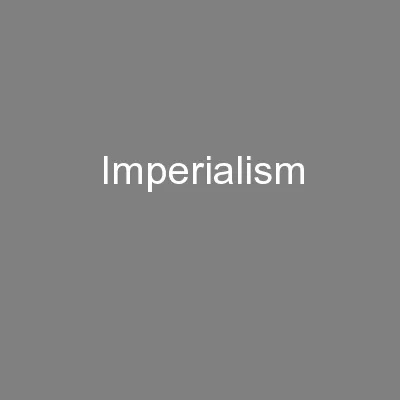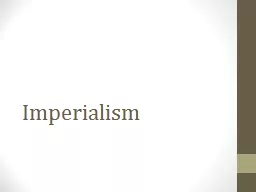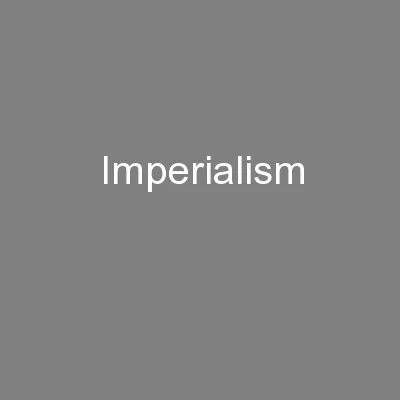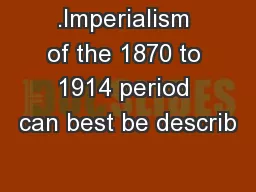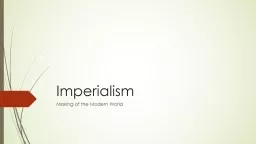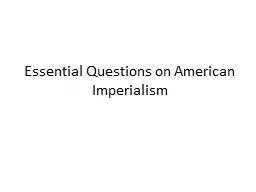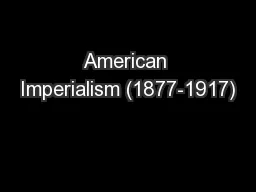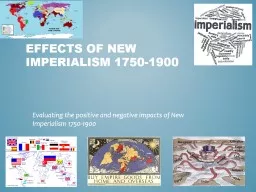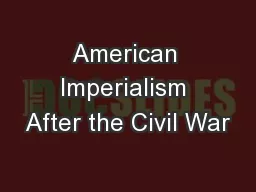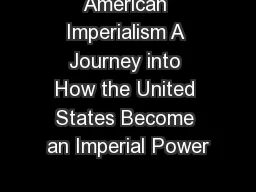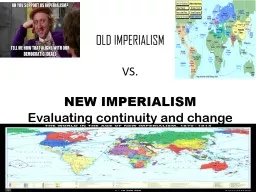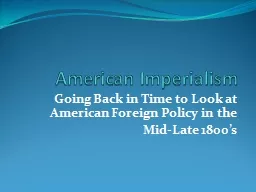PPT-AMERICAN IMPERIALISM BACKGROUND
Author : luanne-stotts | Published Date : 2018-11-03
By the end of the SpanishAmerican War the US was occupying four of Spains former colonies Imperialists saw this as an opportunity They believed the US should take
Presentation Embed Code
Download Presentation
Download Presentation The PPT/PDF document "AMERICAN IMPERIALISM BACKGROUND" is the property of its rightful owner. Permission is granted to download and print the materials on this website for personal, non-commercial use only, and to display it on your personal computer provided you do not modify the materials and that you retain all copyright notices contained in the materials. By downloading content from our website, you accept the terms of this agreement.
AMERICAN IMPERIALISM BACKGROUND: Transcript
By the end of the SpanishAmerican War the US was occupying four of Spains former colonies Imperialists saw this as an opportunity They believed the US should take its own colonies before European countries got them all. Becoming a World Power. Questioning the Causes. Why would the United States choose to enter the competition for foreign lands and markets?. George Washington’s Warning. “entangling alliances”. Early Departures:. How Nationalism Created the Quest for an Overseas Empire.. Age of Imperialism. 1. What is imperialism?. Age of Imperialism. 1. What is imperialism? . Where one nation extends authority & influence over a foreign land & its people. The what, when, who, and why of Imperialism. What is Imperialism?. Economic, political, and social control of one country or territory by another. Similar to (almost exactly the same as) colonization, EXCEPT, in colonization an “invading country” tries to control a new territory and replace all the native inhabitants with its own people, whereas in imperialism the “invading country” simply tries to control a new territory economically, politically, and socially while leaving the native population in place (can you think of examples of countries that were colonized?). Admit Slip. You are a factory owner in Britain during the 1800’s (during the Industrial Revolution). Your factory is in charge of manufacturing desks, doors, tables, and chairs (anything made of wood). Sales have recently declined due to a decrease in the amount of raw materials (lumber) used to make the finished products. In addition to the shortage of lumber, a shortage of coal (natural resources) in your region has caused your business to cut back production as well.. . Gavin K. - Allie P. Josh R. - Kolby S. . Of Africa. Imperialism in Africa. Africa in the Early 1800s. In the early 1800s, Africa was three times the size of Europe; its many people spoke hundreds of languages and had developed varied governments.. Overseas . merchantilism. Development of profitable trade with non-Western regions. Establishment of coastal trading posts in the non-European world. The imposition by Europeans of their social, economic, and political systems upon non-Europeans . Empire & Aftermath. October 2016. Empires in History. Large . territories that control millions of people, . and have . common internal characteristics: management of diverse peoples to exploit resources; communication and transport systems organised to serve the priorities of the imperial centre (metropolis); an imperial project that imposed unity throughout the . What two ideas dominated American political policy prior to the period that saw a growth of imperialistic ideas? . American Industrial Growth. Economic Depression . Anti-Imperialism (those who were against the United States expansion). . Becoming a World Power. Questioning the Causes. Why would the United States choose to enter the competition for foreign lands and markets?. George Washington’s Warning. “entangling alliances”. Early Departures:. Evaluating the positive and negative impacts of New Imperialism 1750-1900. Kipling, a former captain in the British army served in India and identified that it was his duty to Christianize, commercialize and civilize what he called “ Half devil” (not yet Christian) and half child (not yet civilized)” . Little interest in expanding the nation’s territory. . focused on rebuilding the South, industry and settling the west. We were isolationist – isolating one’s nation from the affairs of other nations. Goals and Objectives. I can explain the economic and cultural factors that shaped American foreign policy at the turn of the 20. th. . Century. I will be able to analyze and compare the actions of the United States between 1896-1909 to action of the United States between 1945-present.. Evaluating continuity and change. AFRICA . 1850. AFRICA. 1900. Definition of Imperialism:. The domination by one country of the political . (government & laws). , . economic . (wealth, trade, resources), . Mid-Late 1800’s. Introduction to Imperialism:. ENTRY # . 25. Using the maps on page 457 and 476 in the book …. Where. . and . in what ways . was the United States active in . World . A. ffairs .
Download Document
Here is the link to download the presentation.
"AMERICAN IMPERIALISM BACKGROUND"The content belongs to its owner. You may download and print it for personal use, without modification, and keep all copyright notices. By downloading, you agree to these terms.
Related Documents


